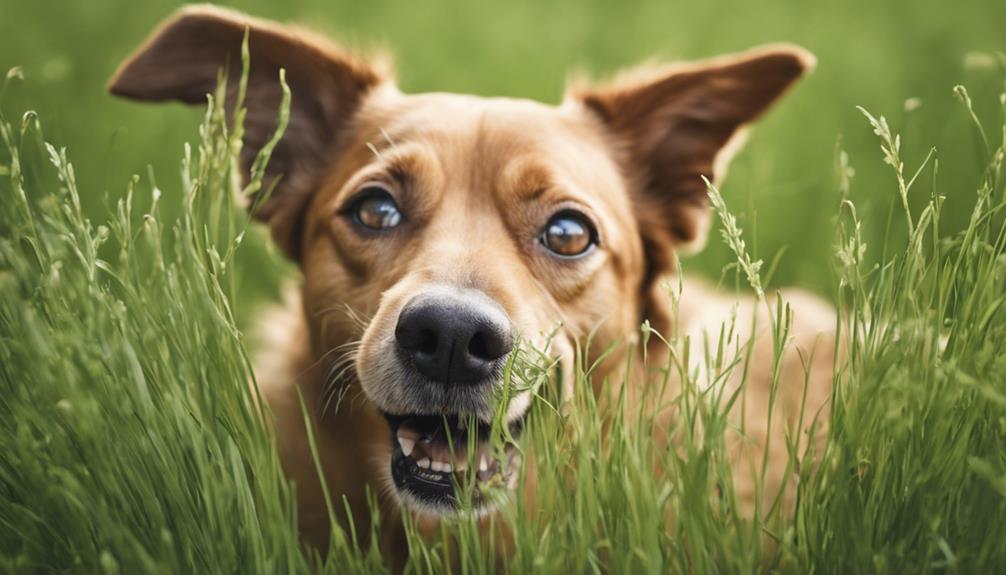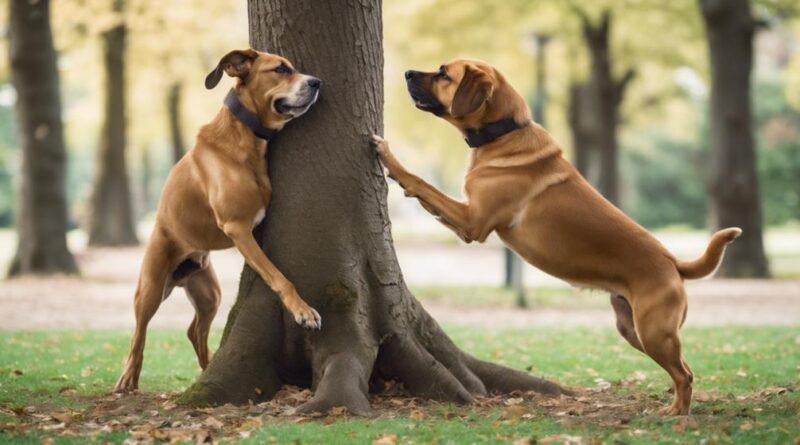Understanding Canine Communication Through Scent
In the intricate world of canine communication, scent serves as a silent yet powerful language that dogs use to convey a multitude of messages.
Have you ever wondered about the hidden conversations your furry companion is having through the scents they encounter? Understanding how dogs interpret and respond to various odors can offer a fascinating glimpse into their social interactions and emotional states.
Let's explore the complex realm of canine communication through scent and unravel the mysteries that lie within this often-overlooked form of expression.
Importance of Scent in Dog Communication
Scent plays a crucial role in how dogs communicate with each other and their environment. Their sense of smell is incredibly powerful, allowing them to pick up on intricate details through scent recognition. Dogs can distinguish individual scents and interpret olfactory cues to understand the world around them. When a dog sniffs another dog, they aren't only smelling their fellow canine but also gathering valuable information about their age, gender, health status, and emotional state. This ability to communicate through scent is a fundamental aspect of their social interactions.
For dogs, scent recognition is more than just identifying familiar smells; it's a way of understanding their surroundings and forming connections with other animals. Olfactory cues provide dogs with a wealth of information that helps them navigate their environment and communicate effectively. By paying attention to scents, dogs can decipher messages left by other animals, mark their territory, and even detect potential dangers. In essence, scent is the primary language through which dogs perceive and interact with the world.
How Dogs Use Scent for Communication
Utilizing their keen sense of smell, dogs effectively convey messages and establish connections with others through olfactory communication. Dogs have remarkable scent tracking abilities, allowing them to interpret a vast array of information through smells. When dogs sniff each other, they're engaging in a form of communication that reveals details about their age, sex, health, emotional state, and even what they had for lunch.
This olfactory communication is vital in how dogs interact and bond with one another. Through scent marking, dogs leave pheromones that serve as messages to other dogs, indicating territory boundaries, social status, or readiness to mate. Moreover, dogs can detect subtle changes in scents, enabling them to sense fear, aggression, or friendliness in other animals or humans.
This ability to communicate through scent is a fundamental aspect of canine behavior, shaping their social dynamics and relationships.
Types of Canine Scent Signals
Dogs communicate through various types of scent signals, conveying important information to others in their environment. One key aspect of canine communication is scent recognition, where dogs can identify familiar scents such as those of their owners, other animals, or specific locations. Through scent recognition, dogs can establish connections, recall memories, and differentiate between various individuals or places based on the unique odors they emit.
Another crucial element in canine scent communication is scent discrimination. This involves dogs being able to distinguish between different scents, even subtle variations within similar odors. By discerning these nuances, dogs can interpret complex messages, assess their surroundings for potential threats or resources, and make decisions based on the information gathered through scent discrimination. This ability is particularly vital in hunting, tracking, and social interactions where dogs rely heavily on their sense of smell to navigate their environment and communicate effectively with other animals.
The Role of Pheromones in Dog Communication
Amidst the intricate web of canine communication lies a fascinating element that plays a significant role in conveying information and influencing behavior: the use of pheromones. Pheromone signals are chemical messengers emitted by dogs that trigger responses in other dogs of the same species. These signals are detected through the remarkable olfactory abilities of canines, which far surpass human capabilities. Canine olfaction allows dogs to perceive pheromones even in minuscule amounts, enabling them to communicate a wide range of messages such as marking territory, signaling reproductive status, indicating fear or aggression, and establishing social bonds.
Pheromones play a vital role in coordinating social interactions among dogs, helping them establish hierarchies within packs, locate mates, and maintain group cohesion. Understanding the significance of pheromones in dog communication sheds light on how these chemical signals shape canine behaviors and relationships. By being attuned to pheromone signals, you can gain insight into the intricate ways dogs communicate with one another through scent.
Scent Marking Behavior in Dogs
In the realm of canine behavior, scent marking plays a crucial role in communication and social interaction among dogs. Dogs use scent marking as a way to establish their territory, a behavior known as territorial marking. By leaving their scent in specific areas, dogs communicate boundaries to other animals, reducing the likelihood of conflicts over space. This behavior is deeply ingrained in their instincts and serves as a form of communication that's essential for their survival in the wild.
Moreover, scent marking isn't only about territoriality but also serves as a means for social bonding among dogs. When a dog marks a particular spot, it leaves behind a scent trail that other dogs can follow. This establishes a form of communication through which dogs can gather information about one another, such as their identity, reproductive status, and emotional state. Through these scent trails, dogs can form connections, strengthen social bonds, and navigate their environment more effectively.
Scent Communication in Pack Dynamics
As canine pack dynamics unfold, the exchange of scents among members plays a pivotal role in establishing hierarchy and fostering cohesion within the group.
- Pack Hierarchy: Through scent marking, dominant dogs can assert their position within the pack, leaving their scent to communicate authority and control over resources like food and resting areas. Submissive dogs, in turn, recognize these scents and show respect by yielding to the dominant members.
- Social Bonding: Scent communication isn't only about dominance but also about social bonding. Dogs greet each other by sniffing, exchanging scents that carry information about their identity, emotional state, and recent activities. This helps in creating a sense of belonging and trust among pack members.
- Maintaining Order: By regularly marking territories and objects with their scents, dogs establish a structured environment within the pack. This helps in reducing conflicts by clarifying boundaries and minimizing misunderstandings regarding each member's role and status.
Interpreting Dog Reactions to Scents

Understanding how dogs react to different scents provides valuable insights into their communication and behavior within a pack. When your dog encounters a scent it finds fearful or anxiety-inducing, you may notice behaviors like cowering, tail tucking, or even attempts to escape the source of the smell. These reactions signal your dog's discomfort or unease, indicating a need for reassurance and support.
On the other hand, when your dog reacts with excitement or curiosity to a scent, you might observe behaviors such as tail wagging, heightened alertness, or attempts to investigate further. These responses suggest that your dog finds the scent intriguing and may want to explore it further. Encouraging this behavior can provide mental stimulation and enrichment for your pet.
Enhancing Canine Communication Through Scent
How can you effectively enhance canine communication through scent? By leveraging scent enrichment techniques, you can significantly improve communication with your furry friend.
Here are three ways to enhance canine communication through scent:
- Scent Enrichment Toys: Provide your dog with interactive toys that dispense treats or have hidden compartments for scents. This engages their sense of smell, making communication more effective.
- Scent Training Games: Engage in scent-based games like hide and seek with scented objects or treats. This helps sharpen your dog's olfactory senses, improving their ability to interpret and communicate through scents.
- Scented Rewards: Use scents as rewards during training sessions. Associating positive scents with good behavior reinforces communication cues and strengthens the bond between you and your dog.
Frequently Asked Questions
Can Dogs Communicate Through Scent Over Long Distances?
Dogs can indeed communicate through scent over long distances. Their scent communication effectiveness and range are impressive due to their acute sense of smell.
Canine scent memory and recognition play a significant role in this form of communication, allowing them to identify individuals, mark territories, and convey information to other dogs even from afar.
This ability showcases the power of scent in facilitating long-distance communication among canines.
How Do Dogs React to Unfamiliar Scents Compared to Familiar Scents?
When you encounter unfamiliar scents, your dog's scent discrimination kicks in, leading to varied behavioral responses. Dogs rely on their canine olfactory memory to distinguish between familiar and unfamiliar scents.
This distinction can affect how they interact socially with other dogs and humans. Familiar scents may elicit a more relaxed response, while unfamiliar scents can trigger curiosity, alertness, or even aversion in your canine companion.
Are There Different Types of Scents That Are More Effective in Conveying Specific Messages to Other Dogs?
When it comes to canine communication through scent, dogs have specific preferences for different types of scents. These preferences are linked to their behavioral responses and how they convey messages to other dogs.
Scent marking plays a crucial role in establishing social hierarchy among dogs. By using various scents, dogs can communicate dominance, submission, or territorial boundaries effectively. Understanding these scent preferences can help you decode the messages dogs are sharing with each other.
Can Dogs Differentiate Between Scents Left by Different Individuals Within Their Pack?
Dogs have an incredible sense of smell, allowing them to easily differentiate between scents left by different individuals within their pack. This ability is crucial for maintaining pack dynamics as it helps establish social hierarchy.
Through scent discrimination and scent marking, dogs can communicate vital information to one another, reinforcing bonds and understanding their place within the group.
This heightened olfactory sense plays a significant role in canine communication and social interactions.
How Do Factors Such as Age, Breed, and Health Affect a Dog's Ability to Interpret and Respond to Scents From Other Dogs?
Age, breed, and health can impact a dog's ability to interpret scents. Breed differences can affect scent communication, with some breeds having keener senses.
Socialization plays a role in how well dogs respond to scents from others. Health issues may also influence a dog's olfactory abilities.
Understanding these factors can help you better comprehend how your furry friend perceives the world through their sense of smell.
Conclusion
Understanding canine communication through scent is crucial for building a strong bond with your furry friend. Dogs use scent to convey messages, mark territory, and navigate their world.
By paying attention to your dog's reactions to scents and incorporating scent-based communication in your interactions, you can enhance your relationship and better understand their needs.
So next time you see your dog sniffing around, remember that they're communicating with you in their own unique way through scent.
